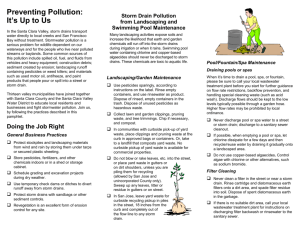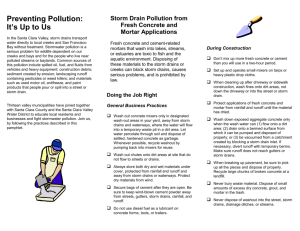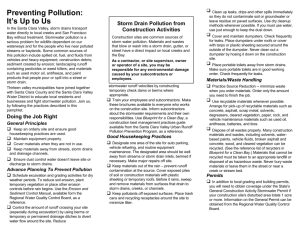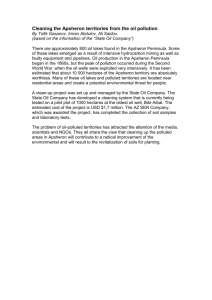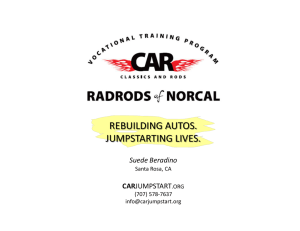Cleaning Industry Questions & Answers (Q&A)
advertisement
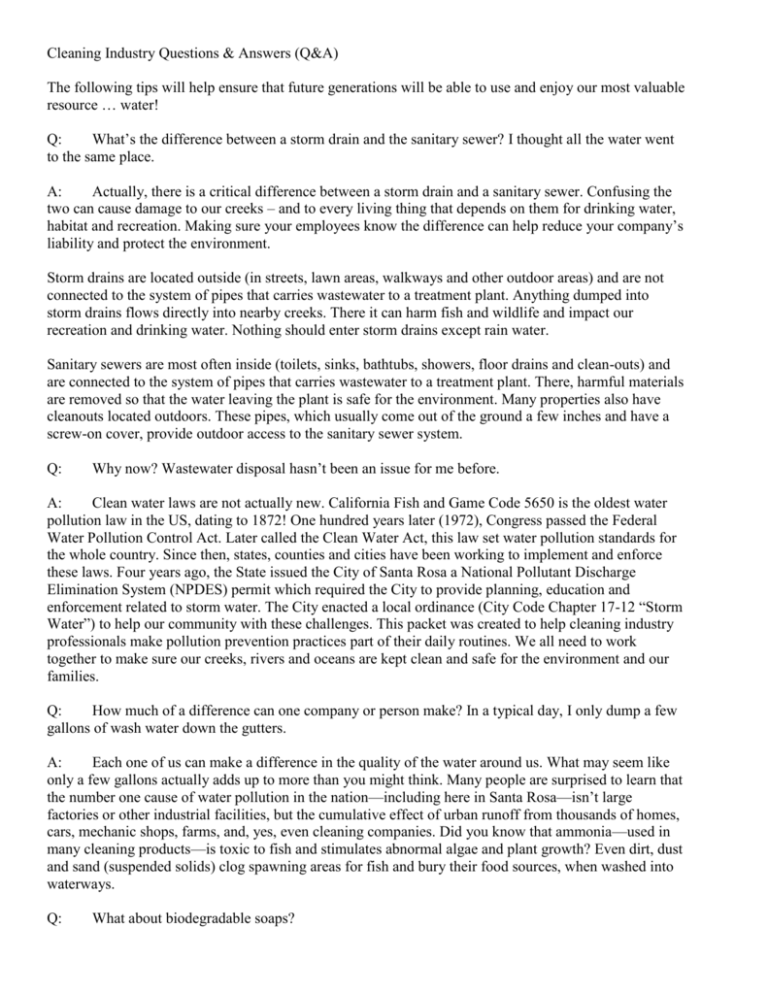
Cleaning Industry Questions & Answers (Q&A) The following tips will help ensure that future generations will be able to use and enjoy our most valuable resource … water! Q: What’s the difference between a storm drain and the sanitary sewer? I thought all the water went to the same place. A: Actually, there is a critical difference between a storm drain and a sanitary sewer. Confusing the two can cause damage to our creeks – and to every living thing that depends on them for drinking water, habitat and recreation. Making sure your employees know the difference can help reduce your company’s liability and protect the environment. Storm drains are located outside (in streets, lawn areas, walkways and other outdoor areas) and are not connected to the system of pipes that carries wastewater to a treatment plant. Anything dumped into storm drains flows directly into nearby creeks. There it can harm fish and wildlife and impact our recreation and drinking water. Nothing should enter storm drains except rain water. Sanitary sewers are most often inside (toilets, sinks, bathtubs, showers, floor drains and clean-outs) and are connected to the system of pipes that carries wastewater to a treatment plant. There, harmful materials are removed so that the water leaving the plant is safe for the environment. Many properties also have cleanouts located outdoors. These pipes, which usually come out of the ground a few inches and have a screw-on cover, provide outdoor access to the sanitary sewer system. Q: Why now? Wastewater disposal hasn’t been an issue for me before. A: Clean water laws are not actually new. California Fish and Game Code 5650 is the oldest water pollution law in the US, dating to 1872! One hundred years later (1972), Congress passed the Federal Water Pollution Control Act. Later called the Clean Water Act, this law set water pollution standards for the whole country. Since then, states, counties and cities have been working to implement and enforce these laws. Four years ago, the State issued the City of Santa Rosa a National Pollutant Discharge Elimination System (NPDES) permit which required the City to provide planning, education and enforcement related to storm water. The City enacted a local ordinance (City Code Chapter 17-12 “Storm Water”) to help our community with these challenges. This packet was created to help cleaning industry professionals make pollution prevention practices part of their daily routines. We all need to work together to make sure our creeks, rivers and oceans are kept clean and safe for the environment and our families. Q: How much of a difference can one company or person make? In a typical day, I only dump a few gallons of wash water down the gutters. A: Each one of us can make a difference in the quality of the water around us. What may seem like only a few gallons actually adds up to more than you might think. Many people are surprised to learn that the number one cause of water pollution in the nation—including here in Santa Rosa—isn’t large factories or other industrial facilities, but the cumulative effect of urban runoff from thousands of homes, cars, mechanic shops, farms, and, yes, even cleaning companies. Did you know that ammonia—used in many cleaning products—is toxic to fish and stimulates abnormal algae and plant growth? Even dirt, dust and sand (suspended solids) clog spawning areas for fish and bury their food sources, when washed into waterways. Q: What about biodegradable soaps? A: Cleaning products labeled “biodegradable” eventually break down, but not before they can be deadly to fish and other aquatic life. Because of their harmful effects to these creek inhabitants, they must be kept out of storm drains and creeks. Q: This sounds like it might be a big hassle and cost a lot. A: Many in the cleaning industry are already using pollution prevention practices in their businesses. These companies have already made the change to techniques and equipment that protect local creeks and find them easy and effective. They’ve also discovered that pollution prevention is good for business. Customers feel better knowing their contractors are cleaning their properties safely and legally. Customers want unpolluted creeks for their families, too, and they know that if a violation is found on their property, they could be held liable in addition to the cleaning company. “Adopting clean water practices wasn’t as costly or difficult as we had thought, and the City was helpful in getting us the information we needed to make the necessary changes. Now, everybody in our company – from the office staff to the workers – works as a team to make sure we do each job right. Our customers like knowing we’re a ‘green’ business, and we’re all proud of the work we do each day.” –Kerry Price, North Bay Mobile Wash Equipment needed for correct pollution prevention practices can range from “low-tech” and inexpensive – like drain covers and wet vacs – to more expensive, depending on the type of work your company performs. See Trade Associations at right for more information. With fines of up to $25,000 per violation per day, not doing it right is just not worth the risk. Q: Where do I start? A: All you need to do is complete and mail in the enclosed reply card or call the City’s Department of Public Works at (707) 543-3800. We have staff training available, including a video and demonstrations tailored to your business. We can also provide more copies of the materials you find in this packet. The goal is for you to take the information you find relevant to your business and incorporate it into your company’s ongoing operations and staff training. Every company and every job site is different, so each new job will require careful thinking and planning to ensure that wastewater does not go down the storm drain. Below are some other numbers you can call for more information: Government Agencies and Municipal Services Emergency spills: Call 911 Storm drain questions: Inside Santa Rosa City Limits: Santa Rosa Public Works: (707) 543-3800 Outside Santa Rosa City Limits Sonoma County Environmental Health: (707) 565-6565 Additional copies of materials: Santa Rosa Public Works: (707) 543-3800 Sanitary sewer discharge requirement questions: Santa Rosa Subregional Industrial Waste Division: (707) 543-3369 Hazardous materials recycling and disposal questions: Sonoma County Ecodesk: (707) 565-DESK Hazardous waste and materials management questions: Inside Santa Rosa City Limits: Santa Rosa Fire Department: (707) 543-3526 Outside Santa Rosa City Limits: Sonoma County Department of Emergency Services: (707) 565-1152 Dumpster service, cleaning or replacement: Empire Waste Management: (707) 585-8848 Trade Associations The following cleaning industry organizations can refer you to vendors of wastewater collection, pre-treatment, and recycling equipment: Cleaning Equipment Trade Association (800) 433-9889 www.ceta.org Power Washers of North America (301) 941-1064 www.pwna.org Carpet & Fabricare Institute (800) CARPET-9. The City of Santa Rosa does not endorse any companies, associations or products.


